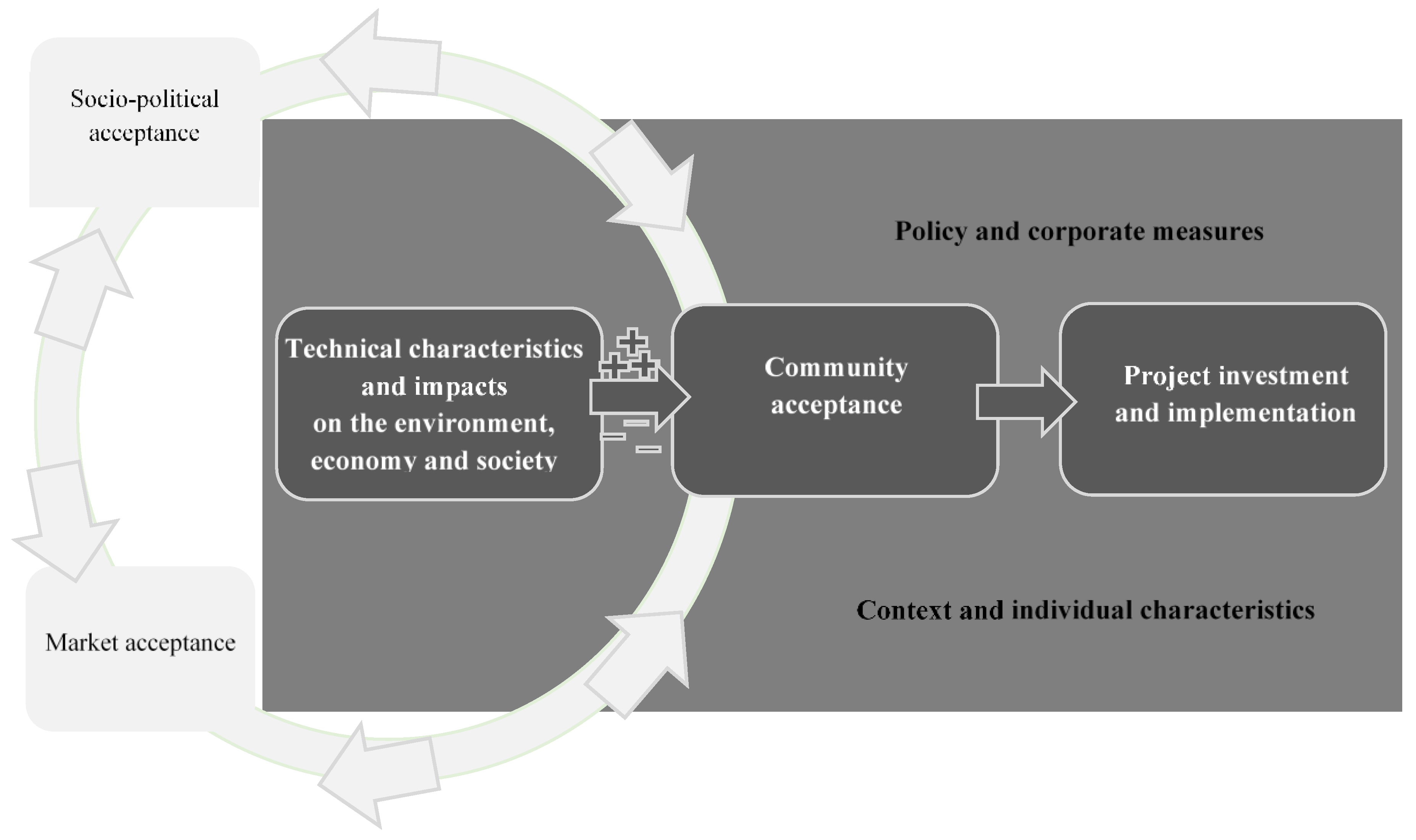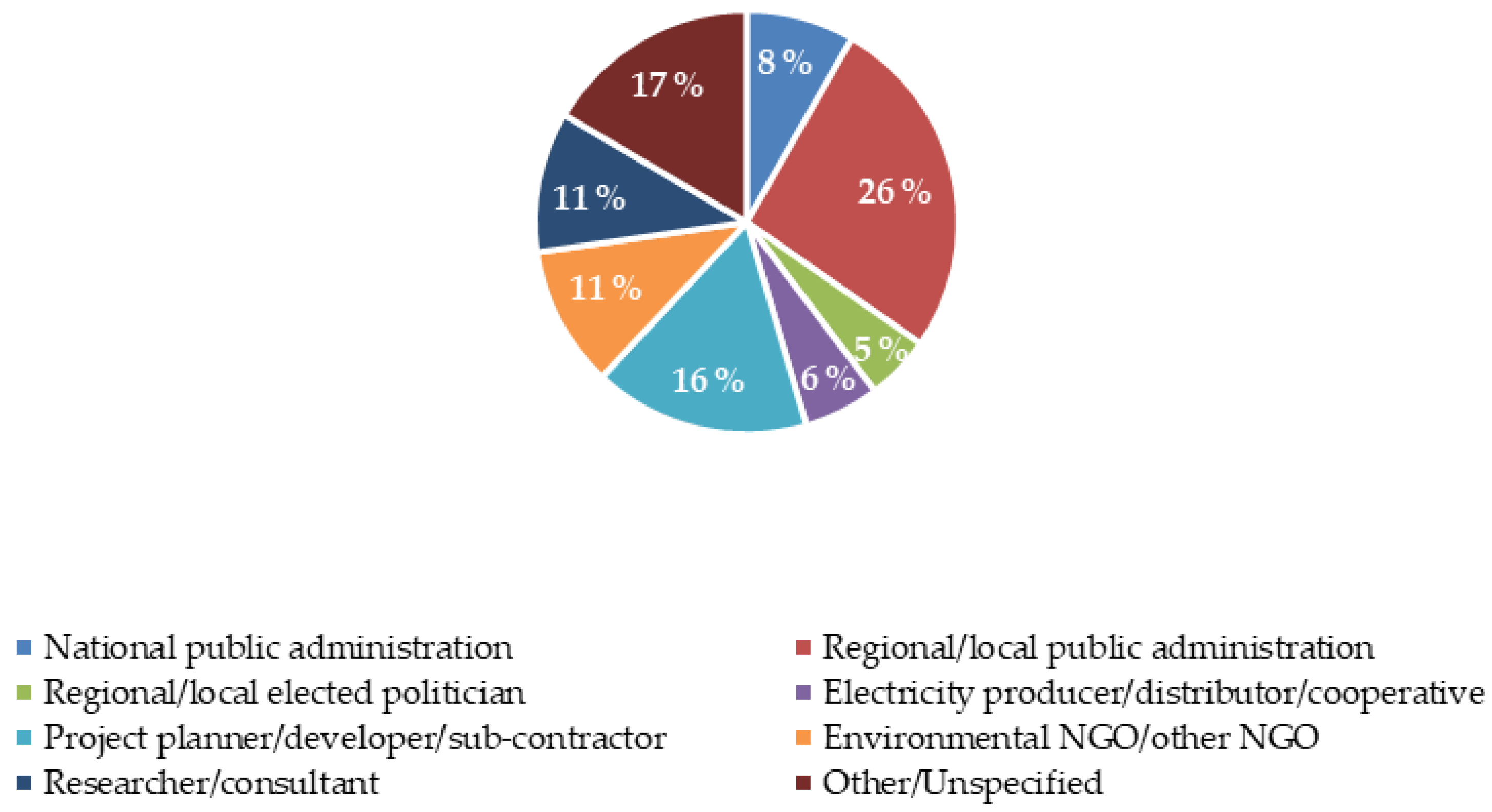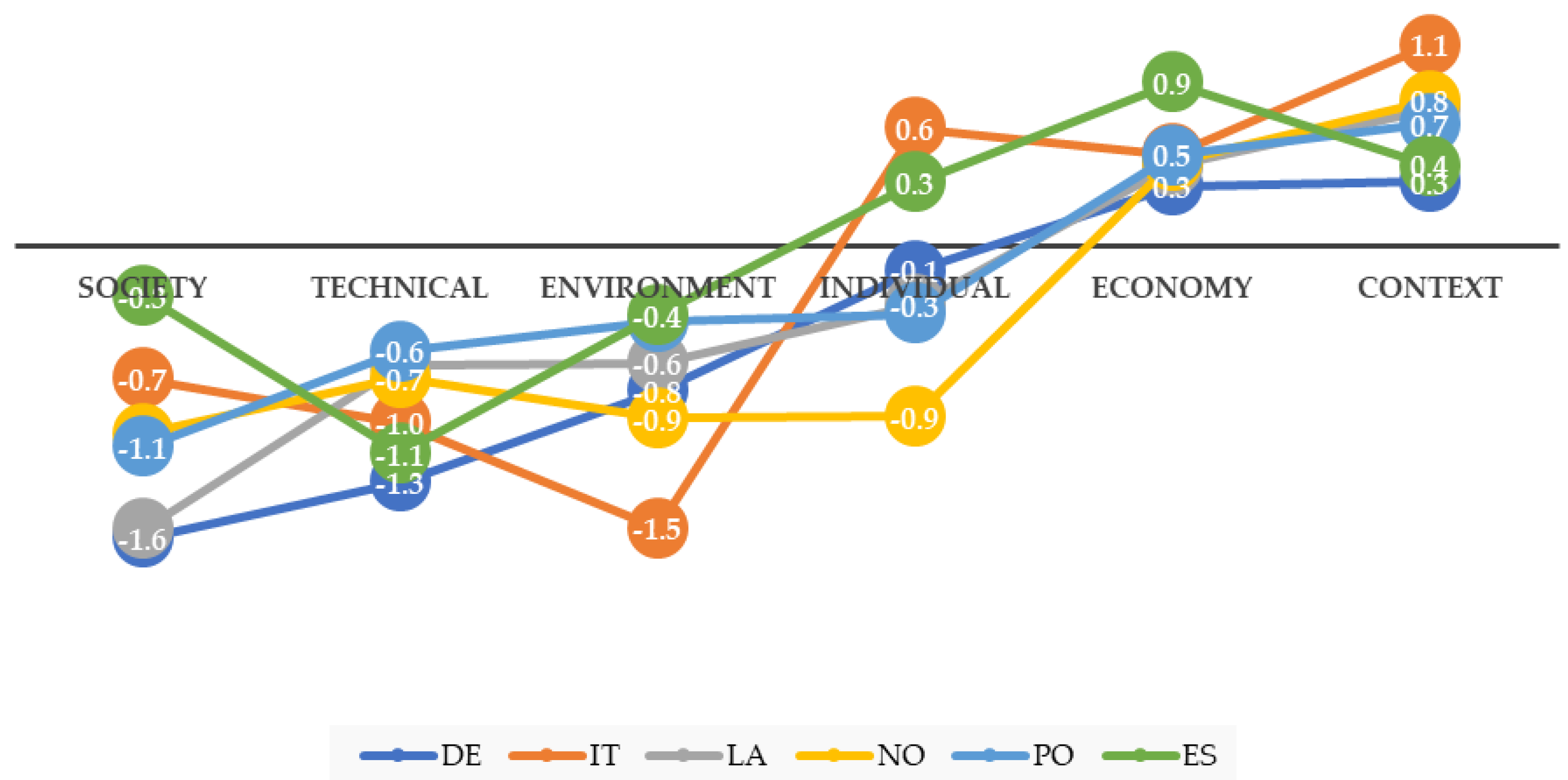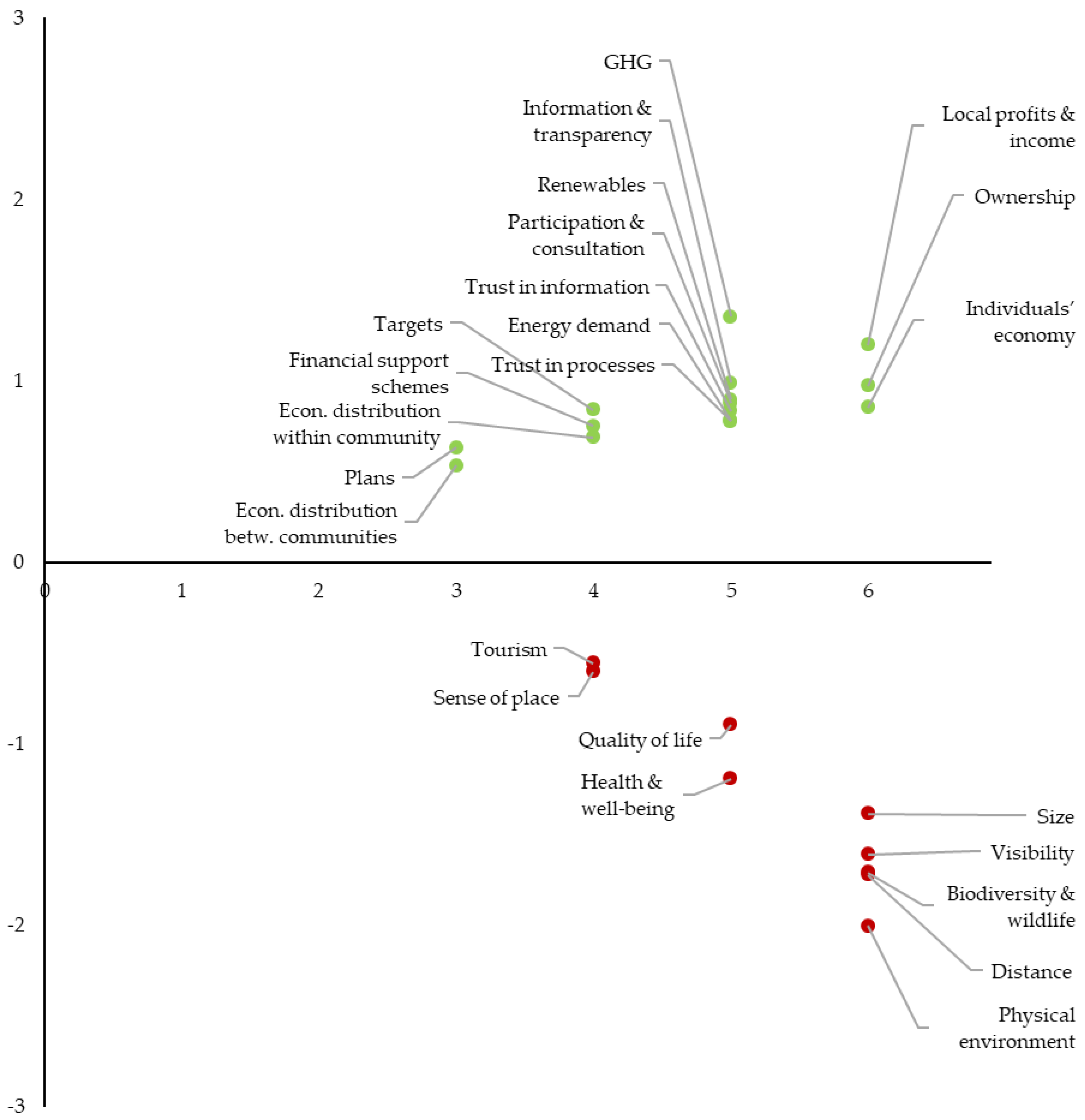Community Acceptance of Wind Energy Developments: Experience from Wind Energy Scarce Regions in Europe
Abstract
1. Introduction
2. Literature Review and Analytical Framework
3. Materials and Methods
3.1. Case Selection
3.2. The Stakeholder Survey
3.3. Data Collection
4. Results
4.1. Cross-case Assessment
4.2. The Criticality of Social Acceptance Barriers and Drivers
- its frequency;
- its level of impact.
4.2.1. The Criticality of Social Acceptance Barriers
4.2.2. The Criticality of Social Acceptance Drivers
4.2.3. Regional Variations in Acceptance-Related Patterns
5. Discussion
6. Concluding Remarks and Recommendations for Policy
Author Contributions
Funding
Acknowledgments
Conflicts of Interest
References
- Iuga, D.; Dragan, M.; Claessens, B.; Dütschke, E.; Schneider, U.; Wesche, J.; Ramsay, J. Final Result-Oriented Report WISE Power, Foster Social Acceptance for Wind Power, October 2016 (Deliverable 1.1). Available online: http://wisepower-project.eu/wp-content/uploads/FINAL_WISE-Power-Result_oriented-report_Deliverable-D1.1-1.pdf (accessed on 5 December 2019).
- Langer, K.; Decker, T.; Roosen, J.; Menrad, L. A qualitative analysis to understand the acceptance of wind energy in Bavaria. Renew. Sust. Energy Rev. 2016, 64, 248–259. [Google Scholar] [CrossRef]
- Jobert, A.; Laborgne, P.; Mimler, S. Local acceptance of wind energy: Factors of success identified in French and German case studies. Energy Policy 2007, 35, 2751–2760. [Google Scholar] [CrossRef]
- Wang, S.; Wang, S. Impacts of wind energy on environment: A review. Renew. Sust. Energy Rev. 2015, 49, 437–443. [Google Scholar] [CrossRef]
- Rygg, B.J. Wind power—An assault on local landscapes or an opportunity for modernization? Energy Policy 2012, 48, 167–175. [Google Scholar] [CrossRef]
- Slattery, M.C.; Johnson, B.L.; Swofford, J.A.; Pasqualetti, M.J. The predominance of economic development in the support for large-scale wind farms in the U.S. Great Plains. Renew. Sust. Energy Rev. 2012, 16, 3690–3701. [Google Scholar] [CrossRef]
- Devine-Wright, P.; Howes, Y. Disruption to place attachment and the protection of restorative environments: A wind energy case study. J. Environ. Psychol. 2010, 30, 271–280. [Google Scholar] [CrossRef]
- Pasqualetti, M.J. Opposing Wind Energy Landscapes: A Search for Common Cause. Ann. Assoc. Am. Geogr. 2011, 101, 907–917. [Google Scholar] [CrossRef]
- Szarka, J. Wind Power in Europe: Politics, Business and Society; Palgrave Macmillan: Basingstoke, UK, 2007. [Google Scholar]
- Knopper, L.D.; Ollson, C.A. Health effects and wind turbines: A review of the literature. Environ. Health 2011, 10, 78. [Google Scholar] [CrossRef]
- Knopper, L.D.; Ollson, C.A.; McCallum, L.C.; Whitfield Aslund, M.L.; Berger, R.G.; Souweine, K.; McDaniel, M. Wind turbines and human health. Front. Public Health 2014, 2, 63. [Google Scholar] [CrossRef]
- Baxter, J.; Morzaria, R.; Hirsch, R. A case-control study of support/opposition to wind turbines: The roles of health risk perception, economic benefits, and community conflict. Energy Policy 2013, 61, 931–943. [Google Scholar] [CrossRef]
- Magari, S.R.; Smith, C.E.; Schiff, M.; Rohr, A.C. Evaluation of community response to wind turbine-related noise in Western New York State. Noise Health 2014, 16, 228. [Google Scholar] [CrossRef] [PubMed]
- Brennan, N.; Rensburg, T.M.V.; Morris, C. Public acceptance of large-scale wind energy generation for export from Ireland to the UK: Evidence from Ireland. J. Environ. Plann. Man. 2017, 60, 1967–1992. [Google Scholar] [CrossRef]
- Liebe, U.; Bartczak, A.; Meyerhoff, J. A turbine is not only a turbine: The role of social context and fairness characteristics for the local acceptance of wind power. Energy Policy 2017, 107, 300–308. [Google Scholar] [CrossRef]
- Zoellner, J.; Schweizer-Ries, P.; Wemheuer, C. Public acceptance of renewable energies: Results from case studies in Germany. Energy Policy 2008, 36, 4136–4141. [Google Scholar] [CrossRef]
- Wolsink, M. Planning of renewables schemes: Deliberative and fair decision-making on landscape issues instead of reproachful accusations of non-cooperation. Energy Policy 2007, 35, 2692–2704. [Google Scholar] [CrossRef]
- Barry, J.; Ellis, G.; Robinson, C. Cool rationalities and hot air: A rhetorical approach to understanding debates on renewable energy. Glob. Environ. Politics 2008, 8, 67–98. [Google Scholar] [CrossRef]
- Devine-Wright, P. Reconsidering Public Attitudes and Public Acceptance of Renewable Energy Technologies: A Critical Review; School of Environment and Development, University of Manchester: Manchester, UK, 2007. [Google Scholar]
- Ribeiro, F.; Ferreira, P.; Araújo, M.; Braga, A.C. Public Opinion on Renewable Energy Technologies: The Portuguese Case; University of Minho: Guimaraes, Portugal, 2014. [Google Scholar]
- Ferguson-Martin, C.J.; Hill, S.D. Accounting for variation in wind deployment between Canadian provinces. Energy Policy 2011, 39, 1647–1658. [Google Scholar] [CrossRef]
- Upham, P.; Oltra, C.; Boso, À. Towards a cross-paradigmatic framework of the social acceptance of energy systems. Energy Res. Soc. Sci. 2015, 8, 100–112. [Google Scholar] [CrossRef]
- Aasen, M.; Vatn, A. Public attitudes toward climate policies: The effect of institutional contexts and political values. Ecol. Econ. 2018, 146, 106–114. [Google Scholar] [CrossRef]
- Fournis, Y.; Fortin, M.-J. From social ‘acceptance’ to social ‘acceptability’ of wind energy projects: Towards a territorial perspective. J. Environ. Plann. Man. 2016, 60, 1–21. [Google Scholar] [CrossRef]
- Linnerud, K.; Aakre, S.; Leiren, M.D. Deliverable 2.2: Conceptual framework for analysing social acceptance barriers and drivers. 2018. Available online: https://winwind-project.eu/fileadmin/user_upload/Resources/Deliverables/WinWind_Deliverable_2.2_Conceptual_framework_final.pdf (accessed on 5 December 2019).
- Wüstenhagen, R.; Wolsink, M.; Bürer, M.J. Social acceptance of renewable energy innovation: An introduction to the concept. Energy Policy 2007, 24, 2683–2691. [Google Scholar] [CrossRef]
- Duong, M.Q.; Grimaccia, F.; Leva, S.; Mussetta, M.; Sava, G.; Costinas, S. Performance analysis of grid-connected wind turbines. U.P.B. Sci. Bull., Ser. C 2014, 76, 169–180. [Google Scholar]
- Anshelm, J.; Simon, H. Power production and environmental opinions—Environmentally motivated resistance to wind power in Sweden. Renew. Sust. Energy Rev. 2016, 57, 1545–1555. [Google Scholar] [CrossRef]
- Ertör-Akyazı, P.; Adaman, F.; Özkaynak, B.; Zenginobuz, Ü. Citizens’ preferences on nuclear and renewable energy sources: Evidence from Turkey. Energy Policy 2012, 47, 309–320. [Google Scholar] [CrossRef]
- Petrova, M.A. NIMBYism revisited: Public acceptance of wind energy in the United States. Wires Clim. Chang. 2013, 4, 575–601. [Google Scholar] [CrossRef]
- Rand, J.; Hoen, B. Thirty years of North American wind energy acceptance research: What have we learned? Energy Res. Soc. Sci. 2017, 29, 135–148. [Google Scholar] [CrossRef]
- Krug, M.; Ohlhorst, D. Optimizing the Local Embedding of Renewable Energy Plants: The Role of Nature Conservation in Relation to other Acceptance Factors. J. Environ. Policy Admin. 2020, 27, 77–102. [Google Scholar]
- Larsen, S.V.; Hansen, A.M.; Lyhne, I.; Aaen, S.B.; Ritter, E.; Nielsen, H. Social impact assessment in Europe: A study of social impacts in three Danish cases. J. Environ. Assess. Policy Manag. 2015, 17, 1550038. [Google Scholar] [CrossRef]
- McCunney, R.J.; Mundt, K.A.; Colby, W.D.; Dobie, R.; Kaliski, K.; Blais, M. Wind Turbines and Health. A Critical Review of the Scientific Literature. J. Occup. Environ. Med. 2014, 56, 108–130. [Google Scholar] [CrossRef]
- Klæboe, R.; Sundfør, H. Windmill noise annoyance, visual aesthetics, and attitudes towards renewable energy sources. Int. J. Environ. Res. Public Health 2016, 13, 746. [Google Scholar] [CrossRef]
- Frantál, B.; Kunc, J. Wind turbines in tourism landscapes: Czech Experience. Ann. Tour. Res. 2011, 38, 499–519. [Google Scholar] [CrossRef]
- Breukers, S.; Wolsink, M. Wind power implementation in changing institutional landscapes: An international comparison. Energy Policy 2007, 35, 2737–2750. [Google Scholar] [CrossRef]
- Enevoldsen, P.; Sovacool, B. Examining the social acceptance of wind energy: Practical guidelines for onshore wind project development in France. Renew. Sust. Energy Rev. 2016, 53, 178–184. [Google Scholar] [CrossRef]
- Boon, F.P.; Dieperink, C. Local civil society based renewable energy organisations in the Netherlands: Exploring the factors that stimulate their emergence and development. Energy Policy 2014, 69, 297–307. [Google Scholar] [CrossRef]
- Maruyama, Y.; Nishikido, M.; Iida, T. The rise of community wind power in Japan: Enhanced acceptance through social innovation. Energy Policy 2007, 35, 2761–2769. [Google Scholar] [CrossRef]
- Walker, B.J.A.; Wiersma, B.; Bailey, E. Community benefits, framing and the social acceptance of offshore wind farms: An experimental study in England. Energy Res. Soc. Sci. 2014, 3, 46–54. [Google Scholar] [CrossRef]
- Warren, C.R.; McFadyen, M. Does community ownership affect public attitudes to wind energy? A case study from south-west Scotland. Land Use Policy 2010, 27, 204–213. [Google Scholar] [CrossRef]
- Linnerud, K.; Toney, P.; Simonsen, M.; Holden, E. Does change in ownership affect community attitudes toward renewable energy projects? Evidence of a status quo bias. Energy Policy 2019, 131, 1–8. [Google Scholar] [CrossRef]
- Ek, K.; Persson, L. Wind farms—Where and how to place them? A choice experiment approach to measure consumer preferences for characteristics of wind farm establishments in Sweden. Ecol. Econ. 2014, 105, 193–203. [Google Scholar] [CrossRef]
- Enevoldsen, P.; Permien, F.-H.; es Bakhtaoui, I.; von Krauland, A.-K.; Jacobson, M.Z.; Xydis, G.; Sovacool, B.K.; Valentine, S.V.; Luecht, D.; Oxley, G. How much wind power potential does europe have? Examining European wind power potential with an enhanced socio-technical atlas. Energy Policy 2019, 132, 1092–1100. [Google Scholar] [CrossRef]
- WindEurope. Wind Energy in Europe in 2018. Trends and Statistics. Published in February 2019. Available online: https://windeurope.org/wp-content/uploads/files/about-wind/statistics/WindEurope-Annual-Statistics-2018.pdf (accessed on 21 January 2020).
- Deutsche Windguard. Status des Windenergieausbaus an Land in Deutschland, 1. Halbjahr 2018. Available online: https://www.windguard.de/veroeffentlichungen.html?file=files/cto_layout/img/unternehmen/veroeffentlichungen/2018/Status%20des%20Windenergieausbaus%20an%20Land%20in%20Deutschland%2C%201.%20Halbjahr%202018.pdf (accessed on 15 November 2019).
- NVE. Vindkraft. Nøkkeltall for Norsk Vindkraftproduksjon i 2018. Available online: https://www.nve.no/energiforsyning/kraftproduksjon/vindkraft/ (accessed on 29 January 2020).
- Terna. Renewable Sources. Available online: https://www.terna.it/en/electric-system/dispatching/renewable-sources (accessed on 21 January 2020).
- Polish Wind Energy Association. The State of Wind Energy in Poland in 2016. Published 2017. Available online: http://psew.pl/en/wp-content/uploads/sites/2/2017/06/Stan-energetyki-wiatrowej-w-Polsce-w-2016-r.pdf. (accessed on 22 November 2019).
- Renewable Energy Statistics. Available online: https://ec.europa.eu/eurostat/statistics-explained/index.php/Renewable_energy_statistics (accessed on 4 December 2019).
- Szulecki, K. Poland: Incumbent stability amid legislative volatility. In Comparing Renewables Policy: The role of Political, Organizational and European Fields; Boasson, E.L., Leiren, M.D., Wettestad, J., Eds.; Routledge: Abingdon, UK, Forthcoming.
- Mosannenzadeh, F.; Di Nucci, M.R.; Vettorato, D. Identifying and prioritizing barriers to implementation of smart energy city projects in Europe: An empirical approach. Energy Policy 2017, 105, 191–201. [Google Scholar] [CrossRef]
- ENEA. Energy Efficiency. Annual Report. Analysis and Results of Energy Efficiency Policies in Italy. Available online: https://www.enea.it/it/seguici/pubblicazioni/pdf-volumi/2018/raee-2018-executivesummary-en.pdf (accessed on 15 January 2020).
- Aakre, S.; Leiren, M.D.; Linnerud, K. Deliverable 2.3: Taxonomy of Social Acceptance Drivers and Barriers. 2019. Available online: https://winwind-project.eu/fileadmin/user_upload/Resources/Deliverables/D2.3_Taxonomy__of_acceptance_barriers_and_drivers__updated.pdf (accessed on 29 January 2020).
- Linnerud, K.; Aakre, S.; Leiren, M.D. Deliverable 2.1: Technical and Socio-Economic Conditions a Literature Review of Social Acceptance of Wind Energy Development, and an Overview of the Technical, Socioeconomic and Regulatory Starting Conditions in the Wind Energy Scarce Target Regions. 2018. Available online: https://winwind-project.eu/fileadmin/user_upload/Resources/Deliverables/Del2.1_final.pdf (accessed on 29 January 2020).
- Maleki-Dizaj, P.; del Bufalo, N. Deliverable 4.3. Synthesis and Comparative Analysis of Best Practice Case Studies for Promoting the Social Acceptance of Wind Energy. Available online: https://winwind-project.eu/fileadmin/user_upload/Resources/Deliverables/Del_4.3.pdf (accessed on 29 January 2020).
- Leiren, M.D.; Reimer, I. Historical institutionalist perspective on the shift from feed-in tariffs towards auctioning in German renewable energy policy. Energy Res. Soc. Sci. 2018, 43, 33–40. [Google Scholar] [CrossRef]
- Oles, T.; Hammarlund, K. The European Landscape Convention, Wind Power, and the Limits of the Local: Notes from Italy and Sweden. Landsc. Res. 2011, 36, 471–485. [Google Scholar] [CrossRef]
- Vatn, A.; og Aasen, M. CICEROs klimaundersøkelse, et dypdykk i folket, vol. 2. Available online: https://cicero.oslo.no/no/klimaundersokelsen-2019 (accessed on 27 January 2020).
- DNT (Den Norske Turistforeningen). Folket Setter Naturen Fremfor Vindkraft. Available online: https://www.dnt.no/artikler/nyheter/17191-folket-setter-naturen-fremfor-vindkraft/ (accessed on 27 January 2020).
- Di Nucci, M.R.; Krug, M. Conditions Enhancing the Socially Inclusive and Environmentally Sound Uptake of Wind Energy: The Case of Germany. J. Environ. Policy Admin. 2018, 26, 1–41. [Google Scholar] [CrossRef]
- FA Wind. Umfrage zur Akzeptanz der Windenergie an Land—Herbst 2019, Berlin. Available online: https://www.fachagentur-windenergie.de/fileadmin/files/Veroeffentlichungen/FA_Wind_Umfrageergebnisse_2019.pdf (accessed on 27 January 2020).






| Acceptance Factor Category | Acceptance Factors | No. |
|---|---|---|
| Technical characteristics of project | The size of modern projects (e.g., number of turbines and turbine height) | 1 |
| The visibility of wind turbines | 2 | |
| The distance of wind turbines from residential areas | 3 | |
| Grid infrastructure improvement | 4 | |
| Other infrastructure improvement (e.g., transport and communications) | 5 | |
| Impacts on Environment | Physical environment (e.g., landscape, protected areas, increased traffic) | 6 |
| Biodiversity and wildlife | 7 | |
| GHG emissions | 8 | |
| Impacts on Economy | Tourism sector | 9 |
| Agricultural sector | 10 | |
| Local profits and income (e.g., jobs, tax, local added value generation) | 11 | |
| Individuals’ economy (e.g., electricity prices, landowners’ income, property value) | 12 | |
| Distribution of benefits and costs between actors within the community | 13 | |
| Distribution of benefits and costs between communities hosting wind power and other communities | 14 | |
| The degree of local ownership of the plants | 15 | |
| Impacts on Society | Health and well-being (e.g., electromagnetic frequencies, shadow flicker, noise) | 16 |
| Quality of life (e.g., recreational opportunities) | 17 | |
| Context | ||
| Market | Regional (or national) share of renewables in the electricity sector | 18 |
| Energy demand (e.g., exporter/importer of electricity, security of supply) | 19 | |
| Planning & permitting process | Opportunities for informal/formal participation and consultation in the planning and permitting process | 20 |
| Information about projects and the transparency of the permitting process | 21 | |
| Trust in processes | 22 | |
| Trust in information | 23 | |
| Governance & regulatory framework | National/regional/local targets | 24 |
| National/regional/local plans | 25 | |
| National/regional/local policies: taxation | 26 | |
| National/regional/local policies: financial support schemes | 27 | |
| Trust in key actors | Trust in national decision-makers | 28 |
| Trust in regional/local decision-makers | 29 | |
| Trust in investors | 30 | |
| Individual characteristics | Socio-cultural values (e.g., equal rights, entrepreneurialism) | 31 |
| Sense of place, self-identity, place attachment | 32 | |
| Discourse on wind energy in the public sphere/media | 33 | |
| Political climate for wind energy development | 34 |
| Barrier | −3 | This factor, by itself, is sufficient to prevent projects from being realized. |
| −2 | This factor has a clear negative impact on social acceptance, but it will not be enough, by itself, to hinder the project from being realized. Yet, the barrier is so important it will have a significant impact on the overall assessment of the social acceptance of the project. | |
| −1 | This factor has a small but negative impact on social acceptance or the negative impacts are slightly greater than the positive impacts, and there are no considerable conflicts related to the acceptance factor. | |
| Neutral | 0 | This factor has an overall neutral impact on acceptance. |
| Driver | 1 | This factor has a small but positive impact on social acceptance or positive impacts are slightly greater than the negative impacts, and there are no considerable conflicts related to the acceptance factor. |
| 2 | This factor will have a clear positive impact on social acceptance, but it will not be enough by itself to guarantee that the project is realized. Yet, the driver is so important it will have a significant impact on the overall assessment of the acceptance of the project. | |
| 3 | This factor, by itself, may be enough to ensure considerable support for the wind energy project. |
| Respondent Affiliation | DE | ES | IT | LA | NO | PO | Sum |
|---|---|---|---|---|---|---|---|
| National public administration | 0 | 0 | 1 | 6 | 3 | 0 | 10 |
| Regional/local public administration | 7 | 3 | 1 | 6 | 5 | 10 | 34 |
| Regional/local elected politician | 3 | 1 | 0 | 0 | 1 | 1 | 6 |
| Electricity producer/distributor/cooperative | 1 | 1 | 1 | 2 | 1 | 1 | 7 |
| Project planner/developer/sub-contractor | 15 | 0 | 2 | 1 | 2 | 0 | 20 |
| Environmental NGO/other NGO | 0 | 0 | 2 | 5 | 6 | 0 | 13 |
| Researcher/consultant | 2 | 3 | 1 | 2 | 2 | 3 | 11 |
| Other/unspecified | 0 | 3 | 3 | 3 | 1 | 10 | 20 |
| Total | 28 | 11 | 11 | 25 | 21 | 25 | 121 |
| Acceptance Factor Category and Acceptance Factor | DE | ES | IT | LA | NO | PO | Avg. Across Regions |
|---|---|---|---|---|---|---|---|
| Technical characteristics of project | |||||||
| Size (1) | −2 | −1 | −1 | −2 | −2 | −1 | −1 |
| Visibility (2) | −2 | −2 | −2 | −1 | −2 | −1 | −2 |
| Distance (3) | −2 | −2 | −1 | −2 | −1 | −2 | −2 |
| Grid infrastructure improvement (4) | −1 | 0 | −1 | 0 | 0 | 0 | 0 |
| Other infrastructure improvement (5) | 0 | 0 | 0 | 1 | 0 | 1 | 0 |
| Impacts on environment | |||||||
| Physical environment (6) | −2 | −2 | −3 | −2 | −2 | −1 | −2 |
| Biodiversity & wildlife (7) | −2 | −1 | −2 | −2 | −2 | −1 | −2 |
| GHG (8) | 1 | 3 | 0 | 2 | 1 | 2 | 1 |
| Impacts on economy | |||||||
| Tourism (9) | −1 | 0 | −1 | 0 | −1 | −1 | −1 |
| Agriculture (10) | 0 | 1 | −1 | −1 | 0 | 1 | 0 |
| Local profits & income (11) | 1 | 2 | 1 | 1 | 2 | 1 | 1 |
| Individuals’ economy (12) | 1 | 1 | 1 | 1 | 1 | 1 | 1 |
| Econ. distribution within community (13) | 0 | 1 | 2 | 1 | 0 | 1 | 1 |
| Econ. distribution betw. communities (14) | 0 | 1 | 1 | 1 | 0 | 0 | 1 |
| Ownership (15) | 1 | 1 | 1 | 1 | 1 | 1 | 1 |
| Impacts on society | |||||||
| Health & well-being (16) | −2 | 0 | −1 | −2 | −1 | −1 | −1 |
| Quality of life (17) | −1 | 0 | −1 | −1 | −1 | −1 | −1 |
| Context | |||||||
| Market | |||||||
| Renewables (18) | 1 | 1 | 1 | 2 | 0 | 1 | 1 |
| Energy demand (19) | 0 | 1 | 1 | 1 | 1 | 1 | 1 |
| Planning & permitting process | |||||||
| Participation & consultation (20) | 1 | 0 | 2 | 1 | 1 | 1 | 1 |
| Information & transparency (21) | 1 | 0 | 2 | 1 | 1 | 1 | 1 |
| Trust in processes (22) | 1 | 0 | 1 | 1 | 1 | 1 | 1 |
| Trust in information (23) | 1 | 0 | 2 | 1 | 1 | 1 | 1 |
| Governance & regulatory framework | |||||||
| Targets (24) | 0 | 2 | 1 | 1 | 0 | 1 | 1 |
| Plans (25) | 0 | 1 | 1 | 1 | 0 | 0 | 1 |
| Taxation (26) | 0 | 1 | 1 | 0 | 1 | 0 | 0 |
| Financial support schemes (27) | 0 | 1 | 1 | 0 | 1 | 1 | 1 |
| Trust in key actors | |||||||
| Trust in nat. decision-makers (28) | 0 | 0 | 1 | 0 | 1 | 0 | 0 |
| Trust in reg./loc. decision-makers (29) | 0 | 0 | 1 | 0 | 1 | 1 | 0 |
| Trust in investors (30) | 0 | 1 | 0 | 0 | 0 | 0 | 0 |
| Individual characteristics | |||||||
| Socio-cultural values (31) | 0 | 0 | 0 | 0 | 0 | 0 | 0 |
| Sense of place (32) | −1 | −1 | 0 | −1 | −1 | 0 | −1 |
| Public discourse (33) | 0 | 1 | 1 | 0 | −1 | 0 | 0 |
| Political climate (34) | 0 | 1 | 2 | 0 | −1 | −1 | 0 |
| Number of barriers | 10 | 6 | 10 | 9 | 11 | 9 | 9 |
| Number of drivers | 9 | 16 | 19 | 15 | 13 | 16 | 15 |
© 2020 by the authors. Licensee MDPI, Basel, Switzerland. This article is an open access article distributed under the terms and conditions of the Creative Commons Attribution (CC BY) license (http://creativecommons.org/licenses/by/4.0/).
Share and Cite
Leiren, M.D.; Aakre, S.; Linnerud, K.; Julsrud, T.E.; Di Nucci, M.-R.; Krug, M. Community Acceptance of Wind Energy Developments: Experience from Wind Energy Scarce Regions in Europe. Sustainability 2020, 12, 1754. https://doi.org/10.3390/su12051754
Leiren MD, Aakre S, Linnerud K, Julsrud TE, Di Nucci M-R, Krug M. Community Acceptance of Wind Energy Developments: Experience from Wind Energy Scarce Regions in Europe. Sustainability. 2020; 12(5):1754. https://doi.org/10.3390/su12051754
Chicago/Turabian StyleLeiren, Merethe Dotterud, Stine Aakre, Kristin Linnerud, Tom Erik Julsrud, Maria-Rosaria Di Nucci, and Michael Krug. 2020. "Community Acceptance of Wind Energy Developments: Experience from Wind Energy Scarce Regions in Europe" Sustainability 12, no. 5: 1754. https://doi.org/10.3390/su12051754
APA StyleLeiren, M. D., Aakre, S., Linnerud, K., Julsrud, T. E., Di Nucci, M.-R., & Krug, M. (2020). Community Acceptance of Wind Energy Developments: Experience from Wind Energy Scarce Regions in Europe. Sustainability, 12(5), 1754. https://doi.org/10.3390/su12051754





